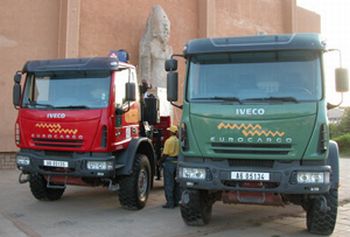 |
|
Two Iveco Eurocargo 4x4s have played a
crucial role in the success of an
archaeological recovery project which has
seen the British Museum working in
conjunction with the Sudan Archaeological
Research Society (SARS), Iveco and New
Holland Construction. |
|
|
|
Two Iveco
Eurocargo 4x4 trucks have played a crucial role in the
success of an archaeological recovery project which has
seen the British Museum working in conjunction with the
Sudan Archaeological Research Society (SARS), Iveco and
also New Holland Construction.
The expedition was carried out by the Castiglioni
brothers and Derek Welsby, curator of the British Museum
Ancient Egypt and Sudan department saw the relocation of
over 50 pieces of rock art and rock gongs dating to
between 5,000 BC – AD 1500 as well as the 390 blocks of
an early Kushite (c. 8th-5th century BC) granite
pyramid, along with its offering chapel and enclosure
wall. The recovered artefacts will form part of a
permanent collection of the British Museum forming an
exhibition dedicated to Ancient Egypt and the Sudan.
The Eurocargos - one equipped with a 6 tonne crane
having a reach of 3 metres and a flatbed platform body;
the other with a steel-reinforced, three-way tipping
body - were provided specifically for the project by the
Iveco Group’s headquarters in Turin, together with items
of specialist construction plant supplied by fellow Fiat
Group company New Holland Construction. The role of the
Eurocargo 4x4s in the project extended well beyond
simply recovering the artefacts as they were also used
to deliver in food and provisions vitally needed to
ensure the success of the project.
The archaeological project took place in the region
surrounding the Fourth Cataract of the Nile in the
Sudan, prior to the damming of the river. The Fourth
Cataract is currently being flooded to provide
hydroelectricity for the region, with the British
Museum/SARS team one of nine international missions
under the banner of the “Merowe Dam Archaeological
Salvage Project”, which have uncovered thousands of
sites dating from the Middle Palaeolithic (150,000 years
ago) to the very recent past.
|